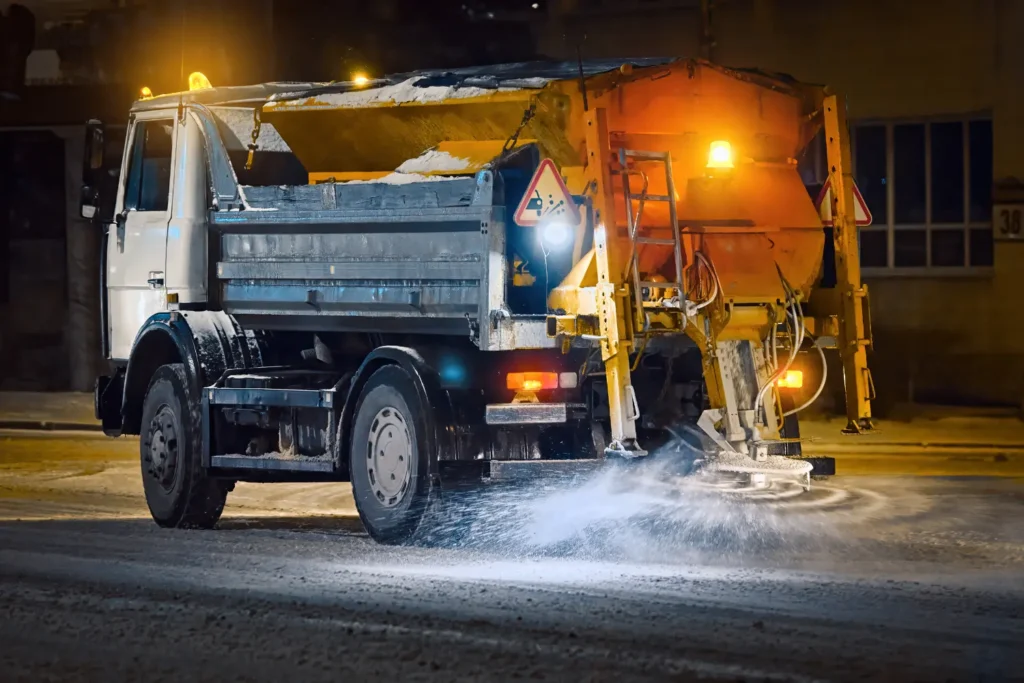Winter gritting is an essential service provided by local authorities and contractors to keep roads, pathways, and other public areas clear of snow and ice during the winter months.
While the primary focus is on safety, it’s essential to consider the environmental impact of the materials and methods used. That’s where ESG comes in. ESG, which stands for Environmental, Social, and Governance, is becoming increasingly important in all industries, including winter gritting.
In this blog, we’ll explore the importance of ESG in winter gritting and why it’s essential to consider the environmental impact of the materials and methods used. We’ll also discuss some of the key things you need to know about ESG in winter gritting, including the benefits of using sustainable materials, the impact of gritting on wildlife, and the importance of responsible and ethical practices.
The Impact of winter gritting on the Environment.
Winter gritting can have a significant impact on the environment. One of the most significant impacts is the use of salt. Salt is commonly used to melt ice and snow on roads and pathways, but it can harm plants and wildlife when it enters the soil. It can also contaminate water sources, which can harm aquatic life. In addition, the use of salt can corrode metal, which can lead to damage to vehicles and infrastructure.
Another impact of winter gritting on the environment is the use of fossil fuels. Many winter gritting vehicles run on diesel, which is a significant source of greenhouse gas emissions. These emissions contribute to climate change and air pollution, which can have negative impacts on public health and the environment.
The social responsibility of winter gritting companies.
Winter gritting companies have a social responsibility to ensure that their operations are not harmful to the environment or the communities they serve. This includes taking steps to minimise the impact of their operations on the environment, such as using sustainable materials and methods and reducing their carbon footprint by using alternative fuels and energy sources.
Winter gritting companies also have a responsibility to ensure that their operations are safe and accessible for all members of the community, including those with disabilities and mobility issues. This includes ensuring that pathways and roads are clear and safe to use and providing alternative access routes and support where necessary.
The benefits of implementing ESG practices in winter gritting.
Implementing ESG practices in winter gritting can have a range of benefits, both for the environment and for the communities served. Some of these benefits include:
Reduced environmental impact: By using sustainable materials and methods, winter gritting companies can minimise the impact of their operations on the environment, including reducing the amount of salt used and the emissions from their vehicles.
Improved public health: By reducing emissions and minimising the impact of salt on water sources, winter gritting companies can help to improve public health and well-being.
Examples of ESG practices in winter gritting.
There are many examples of ESG practices that can be implemented in winter gritting operations. Here at AccuGrit these are some of the actions we’ve taken:
Using alternative de-icing materials: There are many alternative de-icing materials available that are more environmentally friendly than salt. We use the innovative Ice Melt de-icer, which is kinder to the environment than traditional rock salt.
Sourcing Local Suppliers: We stopped importing our brown salt from overseas; instead, it now comes from a salt mine in Winsford Cheshire, significantly reducing the carbon footprint of transportation.
Using electric vehicles: Switching to electric cars can help to reduce emissions and minimise the impact of winter gritting on the environment. In 2021 we began converting our fleet and company cars to EVs.
Using GPS technology: GPS technology can help to improve the efficiency of winter gritting operations, reducing the amount of time vehicles spend on the road and minimising fuel consumption and emissions. All AccuGrit vehicles are route optimised for the most efficient running.
Hybrid Working: Last Year, we introduced hybrid working models for all our employees at HQ to reduce our overall energy output in the office and lower our commuting footprint.
Certifications and Continual Commitment: In 2021 AccuGrit was awarded an ISO Certificate for our Environmental Management System. This ensures that as a business, AccuGrit is accountable for minimising any impact on the ecosystem, and we continue to work hard towards achieving minimal carbon emissions to support climate change.
How we incorporate ESG into your winter gritting operations.
Integrating ESG into winter gritting operations can be a complex process, but there are some steps that we take as standard; these include:
Conducting an environmental assessment: Before implementing ESG practices at a client’s location, we assess your site to identify areas where we can reduce our environmental impact.
Engaging with stakeholders: We will engage with all stakeholders, including local communities, to support our ESG practices and ensure that the company’s operations are aligned with the needs and priorities of the community.
In conclusion, ESG is an essential consideration in winter gritting operations. By implementing sustainable materials and methods and reducing the impact of salt and emissions, winter gritting companies like AccuGrit can help to protect the environment and improve public health and wellbeing.
AccuGrit is committed to leading the industry in the best ESG practices to ensure that winter gritting operations are safe, sustainable, and responsible. To find out more, visit our Environment page.


